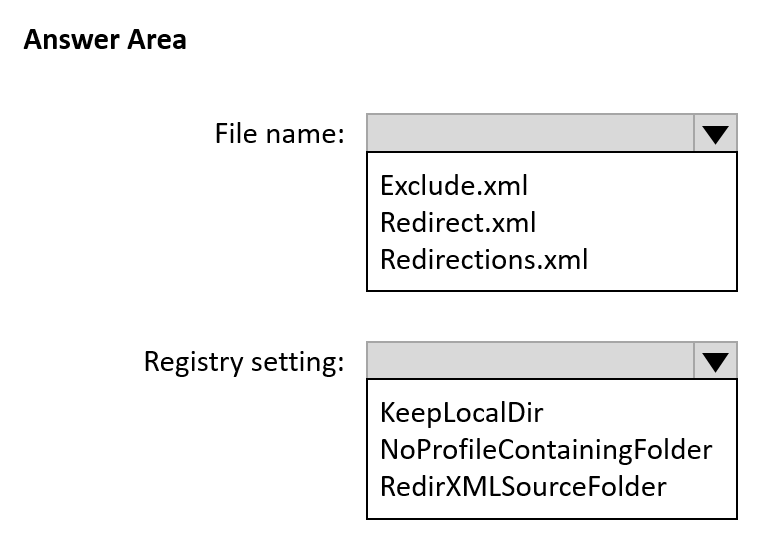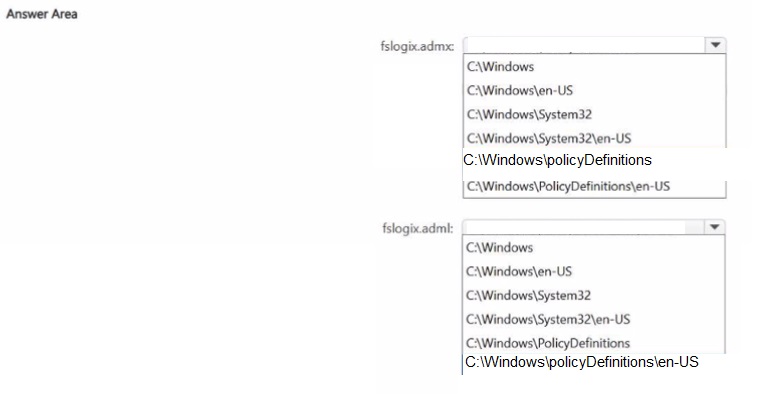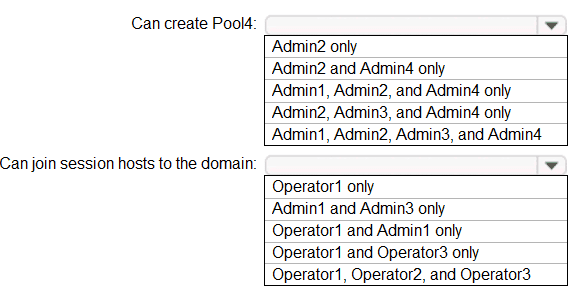AZ-140 Microsoft Configuring and Operating Microsoft Azure Virtual Desktop Free Practice Exam Questions (2025 Updated)
Prepare effectively for your Microsoft AZ-140 Configuring and Operating Microsoft Azure Virtual Desktop certification with our extensive collection of free, high-quality practice questions. Each question is designed to mirror the actual exam format and objectives, complete with comprehensive answers and detailed explanations. Our materials are regularly updated for 2025, ensuring you have the most current resources to build confidence and succeed on your first attempt.
Your on-premises network contains 20 Windows 10 devices.
You have an Azure Virtual Desktop deployment.
You need to deploy the Microsoft Remote Desktop client (MSRDC) to the devices. The MSRDC must be available to everyone who sign in to the devices.
What should you do?
You have a shared image gallery that contains the Windows 10 images shown in the following table.

You create a Windows Virtual Desktop deployment that has the following settings:
Host pool name: Pool1
Location: West US
Host pool type: Personal
Which images can you use for the session hosts?
You have an Azure subscription that contains 500 users. The users are assigned Microsoft Office 365 E1 licenses.
You deploy an Azure Virtual Desktop solution that contains Windows 10 multi-session hosts and streams a custom remote app named App1.
You need to ensure that the users are licensed to stream App1. The solution must minimize costs.
Which license should you use?
-
You have an Azure Virtual Desktop host pool that contains 10 session hosts.
You plan to configure each session host to use an FSLogix profile container that will exclude specific folders in the user profile.
You need to perform the following configurations:
• Create a configuration file to list the excluded profile folders.
• Identify which registry setting will distribute the file to each session host automatically.
What should you name the configuration file, and which registry setting should you identify? To answer, select the appropriate options in the answer area.
NOTE: Each correct selection is worth one point.

You have an Azure Virtual Desktop deployment that contains a host pool named PoolV Pooll contains a session host named Computer! that runs Windows 11 Enterprise muhi session.
You plan to manage the user profiles of Computer1 by using FSLogix.
You need to use Local Group Policy Editor to configure FSLogix on Computer1 by using the English (United States) version of fslogixadmx and fslogix.adml Group Policy administrative template files.
To which folder on Computer1 should you copy the files? To answer, select the appropriate options in the answer area.
NOTE: Each correct selection is worth one point.

You have an Azure Virtual Desktop pooled host pool named HostPool1.
You need to dynamically allocate resources to HostPool1 based on the number of sessions for each host.
What should you create?
You deploy an Azure Virtual Desktop session host pool.
You need to provide a group of pilot users access to the virtual machines in the pool.
What should you do?
You need to evaluate the RDS deployment in the Seattle office. The solution must meet the technical requirements.
Which three actions should you perform in sequence? To answer, move the appropriate actions from the list of actions to the answer area and arrange them in the correct order.

Which role should you assign to Operator2 to meet the technical requirements?
Which three PowerShell modules should you install on Server1 to meet the technical requirements? Each correct answer presents part of the solution.
NOTE: Each correct selection is worth one point.
You are planning the deployment of Pool4.
What will be the maximum number of users that can connect to Pool4, and how many session hosts are needed to support five concurrent user sessions? To answer, select the appropriate options in the answer area.
NOTE: Each correct selection is worth one point.

Which users can create Pool4, and which users can join session hosts to the domain? To answer, select the appropriate options in the answer area.
NOTE: Each correct selection is worth one point.

You need to configure the virtual machines that have the Pool1 prefix. The solution must meet the technical requirements.
What should you use?
Which setting should you modify for VNET4 before you can deploy Pool4?
You plan to implement the FSLogix profile containers for the Seattle office.
Which storage account should you use?
Which host pool design and which service should you configure to meet the disaster recovery requirements? To answer, drag the appropriate solution to the correct requirements. Each solution may be used once, more than once, or not at all. You may need to drag the split bar between panes or scroll to view content
NOTE: Each correct selection is worth one point.

What should you do to meet the application requirements? To answer, select the appropriate options in the answer area.
NOTE: Each correct selection is worth one point.

Which monitoring solution should you configure to meet the security requirements?
Which settings should you configure to meet the performance requirements?
What should you do to meet the user profile requirements?







